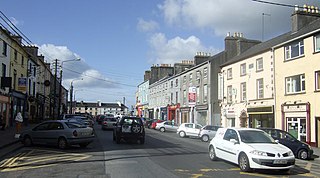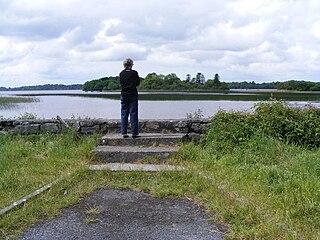
Hever Castle is located in the village of Hever, Kent, near Edenbridge, 30 miles (48 km) south-east of London, England. It began as a country house, built in the 13th century. From 1462 to 1539, it was the seat of the Boleyn family.

Viscount Gough, of Goojerat in the Punjab and of the city of Limerick, was a title in the Peerage of the United Kingdom. It was created in 1849 for the Anglo-Irish military commander Hugh Gough, 1st Baron Gough, whose military successes included the First Opium War, the First Anglo-Sikh War, and the Second Anglo-Sikh War. He had already been created a baronet, of Synone and Drangan, in the Baronetage of the United Kingdom, on 23 December 1842, and Baron Gough, of ChingKangFoo in China and of Maharajpore and the Sutlej in the East Indies, in 1846, also in the Peerage of the United Kingdom. Lord Gough later became a field marshal. The titles became extinct in 2023 following the death of the 5th Viscount.

Field Marshal Hugh Gough, 1st Viscount Gough, was a senior British Army officer. After serving as a junior officer at the seizure of the Cape of Good Hope during the French Revolutionary Wars, Gough commanded the 2nd Battalion of the 87th Regiment of Foot during the Peninsular War. After serving as commander-in-chief of the British forces in China during the First Opium War, he became Commander-in-Chief, India and led the British forces in action against the Marathas defeating them decisively at the conclusion of the Gwalior campaign and then commanded the troops that defeated the Sikhs during both the First Anglo-Sikh War and the Second Anglo-Sikh War.

Gort is a town of around 2,800 inhabitants in County Galway in the west of Ireland. Located near the border with County Clare, the town lies between the Burren and the Slieve Aughty and is served by the R458 and R460 regional roads, which connect to the M18 motorway.

Ó Seachnasaigh, O'Shaughnessy, collectively Uí Sheachnasaigh, clan name Cinél nAedha na hEchtghe, is a family surname of Irish origin. The name is found primarily in County Galway and County Limerick. Their name derives from Seachnasach mac Donnchadh, a 10th-century member of the Uí Fiachrach Aidhne, which the Ó Seachnasaigh were the senior clan of. The town of Gort, Ireland, was the main residence of the family since at least the time of their ancestor, King Guaire Aidne mac Colmáin.

Portumna is a market town in the south-east of County Galway, Ireland, on the border with and linked by a bridge to County Tipperary. The town is located to the west of the point where the River Shannon enters Lough Derg. This historic crossing point over the River Shannon between counties Tipperary and Galway has a long history of bridges and ferry crossings. On the south-western edge of the town lie Portumna Castle and Portumna forest park.

Ashford Castle is a medieval and Victorian castle that has been expanded over the centuries and turned into a five star luxury hotel. It is near Cong on the County Mayo–Galway border, on the County Galway side of Lough Corrib, in Ireland. It is a member of the Red Carnation Hotels organisation and was previously owned by the Guinness family.

Mount Stewart is a 19th-century house and garden in County Down, Northern Ireland, owned by the National Trust. Situated on the east shore of Strangford Lough, a few miles outside the town of Newtownards and near Greyabbey, it was the Irish seat of the Stewart family, Marquesses of Londonderry. Prominently associated with the 2nd Marquess, Robert Stewart, Viscount Castlereagh, Britain's Foreign Secretary at the Congress of Vienna and with the 7th Marquess, Charles Vane-Tempest-Stewart, the former Air Minister who at Mount Stewart attempted private diplomacy with Hitler's Germany, the house and its contents reflect the history of the family's leading role in social and political life in Britain and Ireland.

Castle Ward is an 18th-century National Trust property located near the village of Strangford, in County Down, Northern Ireland, in the townland of the same name. It overlooks Strangford Lough and is 7 miles from Downpatrick and 1.5 miles from Strangford.

East Cowes Castle, located in East Cowes, was the home of architect John Nash between its completion and his death in 1835. Nash himself was the designer of the site, and began construction as early as 1798. It was completed in 1800 and was said to have been built at unlimited expense. Nash was finally interred in the grounds.

Lough Eske or Lough Eask is a small lake in County Donegal, Ireland. The lake lies to the northeast of Donegal Town, to which it is connected by the River Eske. The lake is about 900 acres (3.6 km2) in size and is surrounded to the north, east and west by the Bluestack Mountains, which occupy much of southern County Donegal.
Life Festival is an annual Irish music festival held in Belvedere House and Gardens in Westmeath, Ireland, with arts activities and street performers, from jugglers, fire breathers to magicians. There is a healing area for massage, yoga workshops and reiki.
Crom Castle is a country house on the shores of Upper Lough Erne in County Fermanagh, Northern Ireland, the seat of the Earls Erne. Standing within the 1,900-acre (7.7 km2) Crom Estate, and within a formal garden, the castle is built in stone. A central battlemented tower includes the main entrance, and there are also smaller towers to one side. It stands apart from the ruins of Old Crom Castle, of which two towers, some walls, and a ha-ha survive, and near them two ancient yew trees, believed to be at least 800 years old.
Sir Roger O'Shaughnessy, The O'Shaughnessy, was Chief of the Name and a captain in the Irish army of James II of England. He was present at the Battle of the Boyne, and died ten days after the battle at his castle in Gort. All his property was declared forfeit, and his son and heir, William O'Shaughnessy, was forced into exile.

Lough Rynn Castle is a luxury castle hotel on the shores of Lough Rynn in Gortletteragh County Leitrim, Ireland situated on the historic grounds of the medieval castle and estate of the Mac Raghnaill family of Muintir Eolais.

Sir Thomas Osborne, 5th Baronet, of Tichenor, County Waterford was an Irish baronet and landowner.
Tubber is a small village located in the south of County Galway, Ireland.
Crusheen, formerly called Inchicronan, is a civil parish in County Clare, Ireland. There is also a catholic parish Crusheen, covering the same area. The parish lies to the northeast of Ennis. It contains the villages of Crusheen and Ballinruan.

Lough Cutra is a lake in County Galway, Ireland located beside Lough Cutra Castle. It is the site of a Special Area of Conservation.

Ardamullivan Castle is a tower house and National Monument located in County Galway, Ireland.
















